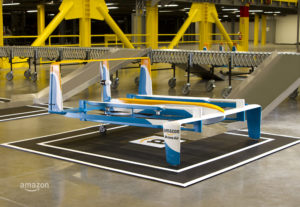 Less than a week after Amazon unveiled a new video imagining a new drone-delivery service in the “not too distant future,” some UAV pundits are already questioning the airworthiness of the Prime Air hybrid drone prototype.
Less than a week after Amazon unveiled a new video imagining a new drone-delivery service in the “not too distant future,” some UAV pundits are already questioning the airworthiness of the Prime Air hybrid drone prototype.
On Sunday, the retailing giant released a new promo video and FAQ page featuring former Top Gear host and British automotive journalist Jeremy Clarkson narrating a dramatized delivery in which Amazon’s fixed-wing/copter hybrid drone saves the day by delivering a pair of soccer cleats to a suburban home just before game time.
Forbes senior editor Philip Elmer-DeWitt is dubious after re-watching the video. “It’s hard to see a shoe box fitting into the narrow fuselage of Amazon’s prototype, Elmer-Dewitt writes in a recent article.
“It looks like a battery-powered amateur aircraft in the same class as the xCraft drones featured recently on ABC’s Shark Tank,” he added.
One of Elmer-DeWitt’s regular readers, identified simply as “Frank, expressed deeper reservations: “While the video claims to be ‘ACTUAL FLIGHT FOOTAGE, NOT SIMULATED,’ something is not right,” Frank writes.
“The videographer is obviously using perspective illusion to simulate a full-size drone in operation. Note that the videographer avoids placing the drone close to objects that would allow the viewer to get a feeling for the actual size of the drone. Judging by the size of the shoebox, assuming the box is about 12 inches long, the drone would be about seven to eight feet long by roughly five to six feet wide, hardly something one would want landing in a back yard, or heaven forbid, a window sill.”
Amazon stands by its claim that the flight depicted in the video is not simulated, telling Forbes that “it’s absolutely carrying the exact brand of sneakers that’s in the video.”
The science blog Phys.org provided an in-depth physics lesson on the aerodynamics of Amazon’s design noting that, while such a craft may prove to be airworthy, the ultimate production model may face challenges.
“The wings and control surfaces add extra weight, reducing flight time, while the rotors, their motors, and the extra structural elements they require will add more weight and drag, reducing its range. It will be interesting to see how Amazon balances these conflicting requirements as their designs progress.”
As reported today in DRONELIFE, Amazon also recognizes that the company must prove the aircraft will be safe in addition to design concerns. A recent company patent notes: “While there are many beneficial uses of these vehicles, they also have many drawbacks. For example, UAVs require involvement to ensure that the vehicles do not collide with other UAVs or other objects.”
Jason is a longstanding contributor to DroneLife with an avid interest in all things tech. He focuses on anti-drone technologies and the public safety sector; police, fire, and search and rescue.
Beginning his career as a journalist in 1996, Jason has since written and edited thousands of engaging news articles, blog posts, press releases and online content.
Email Jason
TWITTER:@JasonPReagan
Subscribe to DroneLife here.







Leave a Reply